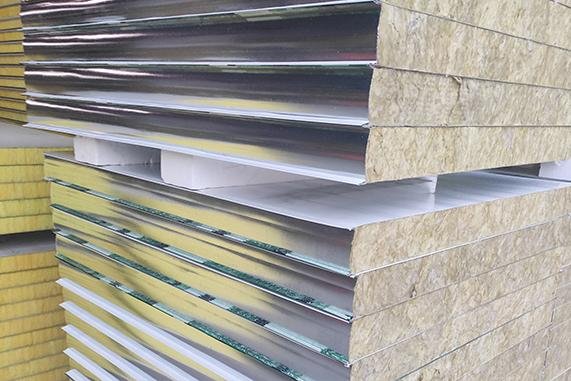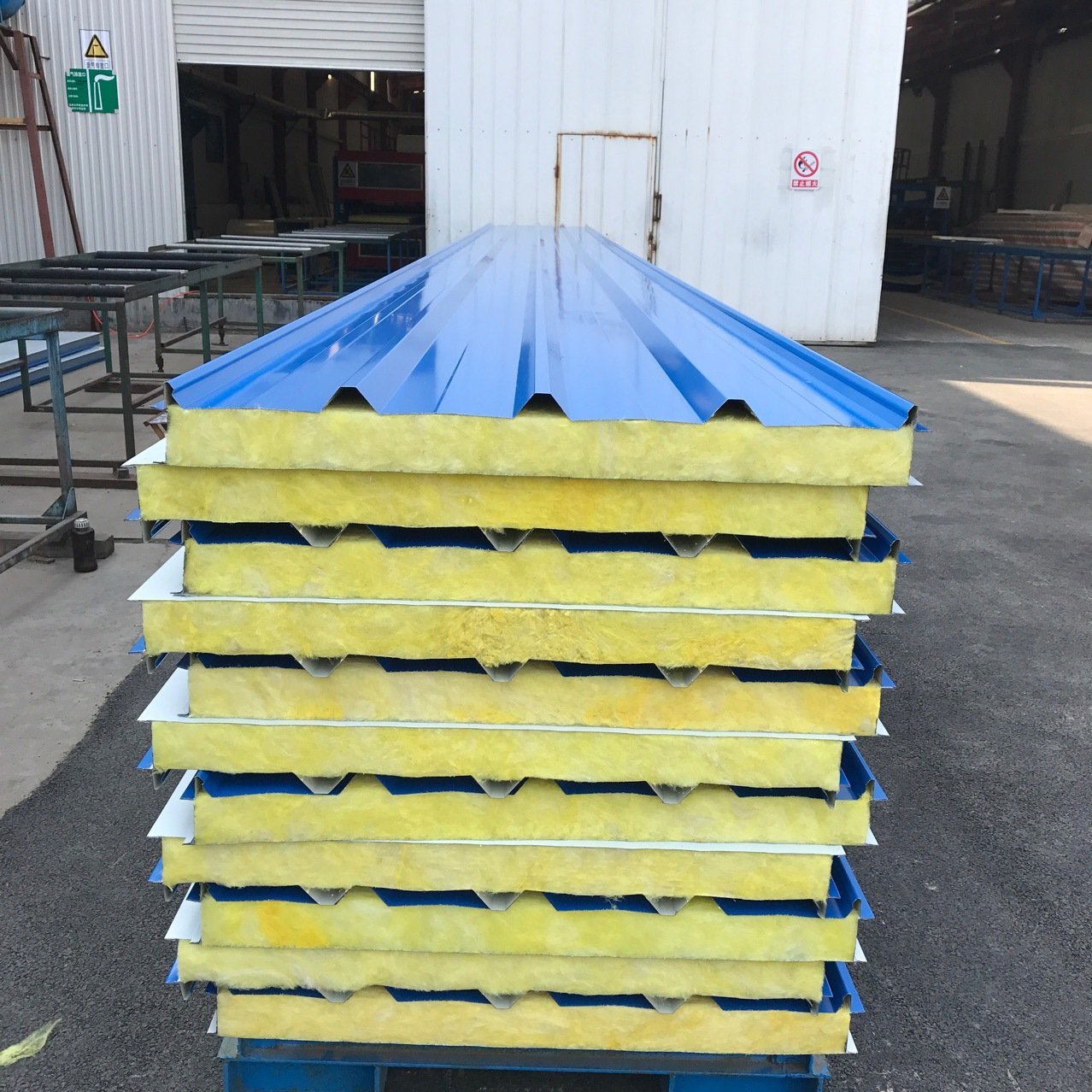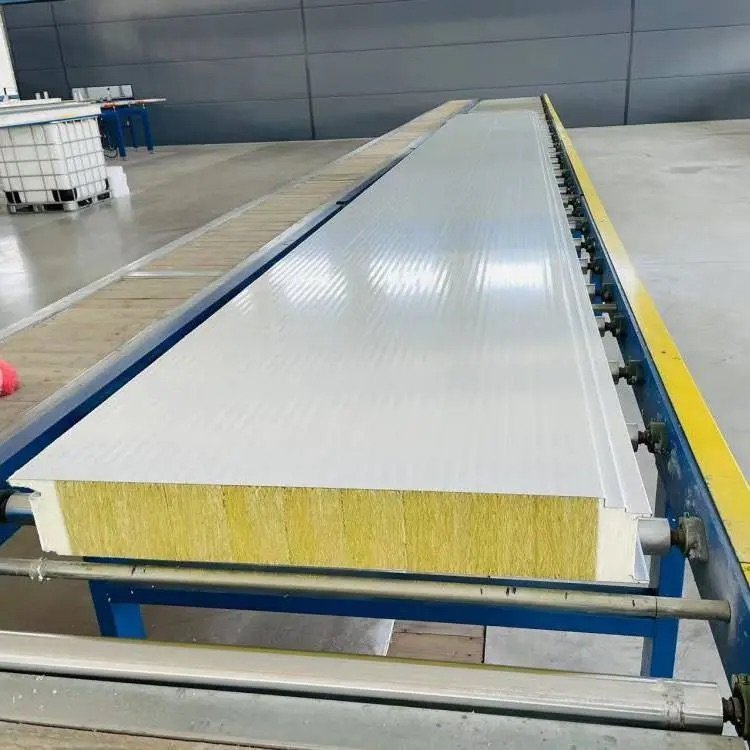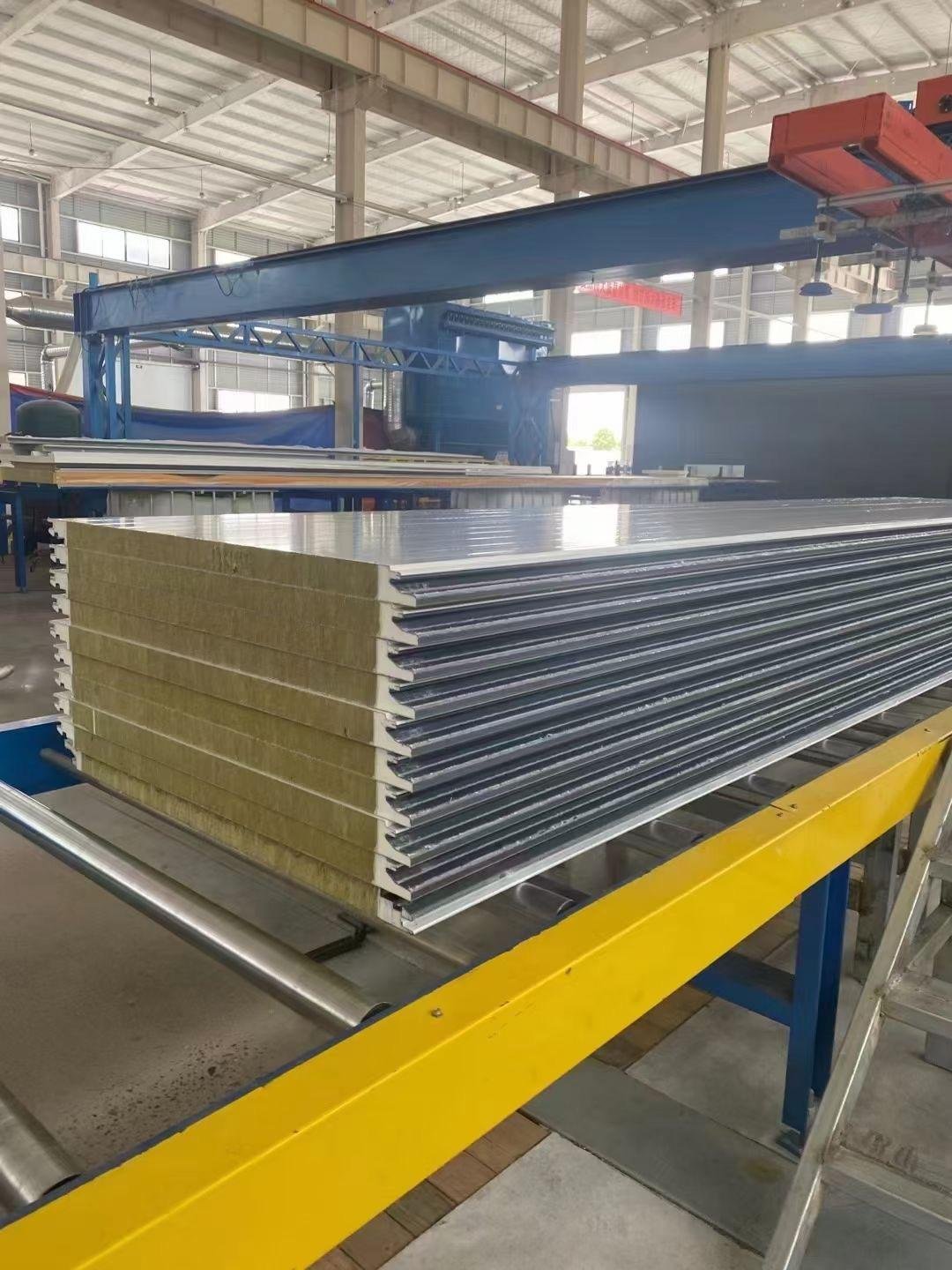
Efficient cooling systems need good insulation, and the Best PU Sandwich Panels lead the way. These panels keep temperatures steady and save energy.
The global market for fresh goods grows 5.8% yearly, raising the need for strong insulation like the Best PU Sandwich Panels.
In India, over 65% of new cold storage walls use the Best PU Sandwich Panels because they block heat and moisture well.
In Europe, the Best PU Sandwich Panels meet energy rules, lowering heating and cooling energy use by up to 40%.
Using the Best PU Sandwich Panels helps make cooling systems both effective and eco-friendly.
Key Takeaways
PU sandwich panels keep temperatures steady and save energy in fridges.
These panels are light and simple to set up, great for new or old buildings.
Picking the right panel thickness can cut energy costs and cool better.
PU panels are strong and last over 50 years, needing fewer fixes.
Fire-safe panels exist, keeping places safe where fires might happen.
Benefits of the Best PU Sandwich Panels

Great Temperature Control
PU sandwich panels are great at keeping temperatures steady. They work well because of these key factors:
Metric | What It Means | Why It Matters |
|---|---|---|
K-value | Shows how much heat passes through; lower is better. | Saves energy and blocks heat effectively. |
U-value | Measures heat transfer; lower means better insulation. | Helps buildings stay energy efficient. |
R-value | Shows resistance to heat flow; higher is better. | Cuts heating and cooling costs. |
These panels stop heat from moving, making cooling systems work better. Picking the Best PU Sandwich Panels helps keep temperatures steady and saves energy.
Saves Energy and Money
PU sandwich panels are made to save energy and cut costs. They block heat well, so thinner panels can still insulate properly. This saves space and boosts energy efficiency.
Choosing the right panel thickness lowers energy bills. These panels keep indoor spaces comfy without extra heating or cooling. Over time, this saves a lot of money, making the Best PU Sandwich Panels a smart buy for cooling systems.
Strong and Long-Lasting
PU sandwich panels are very durable. Research shows they can last over 50 years. For example:
A 28-year-old polyurethane roof tested by FIW Munich still worked like new.
These panels resist damage, staying useful for a long time.
By using the Best PU Sandwich Panels, you get strong, long-lasting insulation. They need fewer repairs or replacements, making them a dependable choice for cooling systems.
Lightweight and Simple to Install
The weight of insulation materials matters for how easy they are to use. The Best PU Sandwich Panels are special because they are light. This makes them easy to move and install. You don’t need big machines or large teams to set them up. They are a great choice for both new buildings and fixing old ones.
Even though they are lightweight, these panels still work well. They keep heat out and save energy. Being light and easy to install saves time and money. Whether for homes or businesses, these panels make work faster and simpler.
Here’s a quick look at why lightweight panels are helpful:
What It Shows | Why It’s Good |
|---|---|
Easy to carry and install | |
They are light, insulate well, and are easy to set up. | Save energy, simple to use |
These panels also lower the weight on your building. This is useful for projects where weight is a problem. Picking the Best PU Sandwich Panels makes your work easier and your building stronger.
Types of the Best PU Sandwich Panels

Core Material Choices
The core inside PU panels affects how well they insulate. Different cores have special benefits for cooling systems. For example, cubic-patterned cores absorb more energy and handle impacts better. Silicone cores reduce damage by 60%, making them great for tough conditions.
Here’s a table comparing common core materials in PU panels:
Panel Type | Heat Transfer | Weight | Strength vs. Weight | Uses |
|---|---|---|---|---|
PUR | Low | Light | Very Strong | Cooling Systems |
PIR | Lower than PUR | Light | Very Strong | Cooling Systems |
Rock Wool | Higher | Heavy | Moderate | General Use |
Picking the right core helps your cooling system work well and last long.
Panel Thickness Choices
The thickness of PU panels changes how well they insulate. Thicker panels block heat better, which is key for keeping things cold. For example, a 6-1/2″ PUR panel has an R-value of 35.1. This is much better than EPS or XPS panels of the same size.
Here’s a table showing how thickness affects insulation:
Thickness | EPS | XPS | PUR |
|---|---|---|---|
4-1/2″ | 13.1 | 17.7 | 22.7 |
6-1/2″ | 19.9 | 27.2 | 35.1 |
8-1/4″ | 26.0 | 35.5 | 46.0 |
10-1/4″ | 32.9 | 45.0 | NA |
12-1/4″ | 39.8 | 54.6 | NA |
Choosing the right thickness saves energy and lowers costs for cooling systems.
Surface Finishes and Coatings
The outer layer of PU panels makes them stronger and protects them. Coatings like polyester or PVC stop rust, water, and sun damage. These finishes also make the panels look better for visible areas.
For cooling systems, anti-bacterial coatings are common. They stop germs from growing, keeping food storage clean and safe. Picking the right finish makes panels last longer and keeps spaces hygienic.
Fire-Resistant PU Panels
Fire safety is very important for cooling systems. PU sandwich panels with fire-resistant features add extra protection. They help meet strict safety rules and reduce fire risks. These panels slow flames, lower smoke, and limit fire damage.
Fire-resistant PU panels go through tough tests to meet safety rules. These tests check how the panels handle fire, smoke, and strength. Below is a table of key fire safety standards and what they mean:
Standard | What It Tests | Why It Matters |
|---|---|---|
EN 13501-1 | Rates materials from A1 (best) to F (worst) | Helps pick safer materials based on fire resistance. |
EN 13823 | Checks flame spread and smoke | Shows how fast flames can move on the material. |
ASTM E84 | Tests flame spread and smoke in materials | Important for U.S. fire safety checks. |
NFPA 285 | Tests how walls handle fire | Key for wall fire safety performance. |
ISO 13784-1 | Measures flame spread, smoke, and dripping particles | Ensures panels follow safety rules. |
Third-party certifications | Done by trusted groups like FM Approvals and ISO | Confirms panels meet top safety standards. |
These certifications prove fire-resistant PU panels are very safe. For example, EN 13501-1 rates show how well panels resist fire. Higher ratings mean better safety, giving you confidence in using them.
Besides safety, these panels also insulate well. They combine fire safety with energy savings. Choosing fire-resistant PU panels makes cooling systems safer and efficient.
Picking the Best PU Sandwich Panels

Temperature Needs
Think about the temperature range for your project. PU sandwich panels keep heat from moving, with a low thermal conductivity of 0.022 W/mK. This means they are great for keeping things cold or hot. They work well in temperatures up to 110°C, making them useful in many settings.
You can pick panel thicknesses like 40, 50, 75, 100, or 200mm. Thicker panels insulate better, which helps keep cold storage or freezers at steady temperatures. These panels are lightweight but strong, with densities between 38-45kg/m³.
Moisture Protection
Humidity can ruin insulation, but PU panels block moisture well. This makes them great for wet places like farms or crop storage. Their moisture resistance keeps them working and durable for a long time.
In the U.S., more farms use climate-controlled buildings. This shows how important it is to have materials that handle humidity. PU panels protect cooling systems from water damage and last longer.
Special Uses
Different projects need different features, and PU panels can adapt. Food factories may need panels with anti-bacterial coatings for cleanliness. Labs and clean rooms often need panels that insulate well and resist fire.
Think about what your project needs, like temperature control, cleanliness, or fire safety. Choosing the right PU panels helps your system work better and meet your goals.
Budget and Long-Term Costs
When picking PU sandwich panels, think about both the price now and the money you’ll save later. These panels might cost more at first, but they save money over time. Their great insulation lowers energy bills, making them a smart choice for cooling systems.
PU sandwich panels help cut costs in many ways:
Energy Savings: These panels stop heat from moving, so cooling uses less power. This means lower electricity bills.
Durability: They last over 50 years, needing fewer repairs or replacements. This saves on maintenance costs.
Resale Value: Good PU panels can make your property worth more, especially for food storage or medicine industries.
Extended Warranties: Many brands offer long warranties, giving you more value for your money.
Studies show PU panels save more money in the long run because they are energy-efficient and strong. For example, one building using PU panels cut energy costs by 30% in the first year.
To use your budget wisely, think about what you need. Look at things like insulation strength, fire safety, and water resistance. PU panels may cost more upfront, but their long-term savings make them worth it.
By choosing PU sandwich panels, you’re not just buying insulation. You’re getting a solution that saves money, works well, and adds value to your property.
Comparison with Other Insulation Materials

PU vs. PIR (Polyisocyanurate)
PU and PIR panels are both great for insulation. PIR has better thermal conductivity, as low as 0.019 W/mK. PU ranges from 0.022 to 0.026 W/mK. This makes PIR better for extreme temperatures.
Here’s a simple comparison:
Attribute | PU Foam | PIR Foam |
|---|---|---|
Fireproof Performance | B3 grade, can reach B1/B2 | Usually B2, can reach B1 |
Insulation Performance | 0.022-0.026 W/mK | As low as 0.019 W/mK |
Weight Capacity | 38-40 Kg/m³ | 40-45 Kg/m³ |
Temperature Resistance Range | -185℃ to +110℃ | -196℃ to +205℃ |
Water Absorption Rate | 2.5% – 3% | Can go as low as 0.9% |
Production Efficiency | Lower than PIR | Higher than PU |
Mechanical Strength | Lower than PIR | Stronger than PU |
PU panels are cheaper and easier to make. They are great for regular cooling systems. But if you need stronger panels or better fire resistance, PIR is a better choice.
PU vs. EPS (Expanded Polystyrene)
PU panels are better than EPS in insulation and strength. PU has lower thermal conductivity, saving more energy. It also lasts longer and is stronger than EPS.
Material Type | Thermal Conductivity | Compressive Strength |
|---|---|---|
PU Sandwich Panels (HPEPC) | ~0.25 of EPS mortar | ~8 times greater than EPS mortar |
EPS is lighter and costs less. However, it doesn’t insulate or last as well as PU. If you want energy savings and durability, PU is the smarter pick.
PU vs. Rockwool
Rockwool and PU panels are used for different needs. Rockwool is excellent for fire safety. It can handle heat up to 1000°C without burning. PU panels are better for keeping heat out, with lower thermal conductivity.
Key differences include:
Fire Resistance: Rockwool handles extreme heat, losing only 10% mass at 800°C. PU resists flames but isn’t fully fireproof.
Thermal Insulation: PU saves more energy with better insulation.
Weight: PU panels are lighter and easier to install. Rockwool is heavier (32–152 kg/m³) but slows heat transfer well.
If fire safety is most important, pick Rockwool. For energy savings and easy setup, PU panels are the best choice.
Unique Benefits of PU Panels
PU sandwich panels have special benefits that make them great for cooling systems. They provide excellent insulation, last a long time, and can be customized for different uses.
Better Insulation:
PU panels keep temperatures steady with high R-values of 6–7 per inch. This is better than EPS panels, which only reach 4–5. The strong polyurethane cores also have low thermal conductivity of 0.022 W/m·K. This helps cut HVAC energy costs by 18–25% over time.Saves Money Over Time:
These panels lower energy use in cold storage buildings. They can reduce lifetime costs by up to 30%. Many supermarkets and cold chain companies now use PU panels. For example, Southeast Asia’s cold storage grew 18% in 2022, with many using PU panels to handle humid weather.Stops Moisture and Lasts Long:
PU panels block moisture, making them perfect for wet places. They are strong and stay effective for many years. This is why industries trust them for cold rooms and storage spaces.Fits Different Needs:
PU panels can be made to match specific needs. You can get fire-resistant coatings, anti-bacterial finishes, or different thicknesses. This makes them useful for food factories, clean rooms, and more.
Choosing PU sandwich panels gives you energy savings, durability, and flexibility. These features make them the best choice for cooling systems everywhere.
Uses of PU Sandwich Panels in Refrigeration Systems

Cold Storage Buildings
Cold storage buildings need good insulation to stay cold. PU sandwich panels are great for this job. They keep heat out and maintain steady temperatures. This is important for storing food, dairy, and medicines.
These panels also block moisture, stopping condensation. This protects stored items and keeps the space clean. Their lightweight design makes them easy to install. This saves time when building large cold storage units. Using PU sandwich panels ensures energy-efficient and reliable storage solutions.
Industrial Freezers
Industrial freezers need strong insulation for very cold temperatures. PU sandwich panels work well here because they insulate efficiently. They have low thermal conductivity, between 0.020 and 0.030 W/mK. They can handle temperatures from -40°F to 176°F.
Here’s a quick look at their features:
Feature | Details |
|---|---|
Thermal Conductivity | |
Temperature Range | -40°F to 176°F |
Water Absorption | ≤ 1.5% |
Vapor Permeability | ≤ 0.1 ng/Pa·m²·s |
Compressive Strength | ≥ 150 kPa |
Insulation Efficiency | Keeps internal temperatures steady. |
These panels resist water and vapor, making them last longer. By choosing PU sandwich panels, you improve freezer efficiency and durability.
Clean Rooms and Labs
Clean rooms and labs need controlled environments for safety and accuracy. PU sandwich panels help by providing great insulation and special finishes. Anti-bacterial coatings stop germs and keep the space clean.
These panels are also fire-resistant, meeting strict safety rules. Their lightweight design allows for quick setup, reducing delays during construction. Whether for a lab or clean room, PU sandwich panels offer the insulation and safety you need.
Food Processing Units
Food processing units need steady temperatures and cleanliness for safety. PU sandwich panels are perfect for these needs. They insulate well and can be customized for food facilities.
Why PU Sandwich Panels Work Well for Food Processing
Temperature Stability:
PU sandwich panels keep temperatures steady, which is vital for food safety. Their low thermal conductivity (0.022 W/mK) stops heat transfer and saves energy.Hygienic Surfaces:
These panels have anti-bacterial coatings. This stops bacteria and mold, keeping food areas clean and safe.Moisture Resistance:
Humidity can ruin insulation and lower hygiene. PU panels block moisture, preventing condensation and water damage.Fire Safety:
Fire-resistant PU panels meet strict safety rules. They lower fire risks in places with heat or flammable items.
Tip: Pick panels with anti-bacterial coatings and fire-resistant features for safer food processing spaces.
Key Features Summarized
Feature | Why It’s Good for Food Units |
|---|---|
Low Thermal Conductivity | Keeps temperatures steady and saves energy. |
Anti-Bacterial Coatings | Stops germs and keeps areas clean. |
Moisture Resistance | Blocks water damage and condensation. |
Fire Resistance | Makes spaces safer from fire risks. |
Simple Setup and Long Life
PU sandwich panels are light and easy to install. This saves time and money during construction. They last for years with little upkeep. You won’t need frequent repairs or replacements.
Using PU sandwich panels creates a clean, safe, and efficient food processing space. These panels help meet industry rules while cutting energy costs.
PU sandwich panels are great for cooling systems. They stop heat well with low thermal conductivity (0.022–0.028 W/m·K). This saves energy and lowers cooling costs. The cold chain market is growing fast and may pass $450 billion by 2027. More cold storage is being built, like for Brazil’s poultry exports, showing their rising need.
These panels are strong, flexible, and easy to set up. They work well for cold storage or food factories. PU sandwich panels give top insulation and save energy. Pick them to improve cooling and meet your needs easily.
FAQ
Why are PU sandwich panels better than other insulation materials?
PU sandwich panels keep heat out well. They have low thermal conductivity (0.022 W/mK). This saves energy. They last longer and block moisture better than EPS or Rockwool. They are light, making them easy to install.
Can PU sandwich panels be used in wet places?
Yes, PU sandwich panels block water well. Their special structure stops water from getting in. This makes them great for wet places like cold storage or food factories. They stay strong and work well over time.
Are PU sandwich panels safe from fire?
Many PU sandwich panels have coatings that resist fire. They meet strict safety rules like EN 13501-1 and ASTM E84. These panels slow down flames and make less smoke. They help keep refrigeration systems safe from fire.
How do I pick the right thickness for PU sandwich panels?
Choose thickness based on how much insulation you need. Thicker panels keep heat out better. For cold storage, 100mm to 200mm panels are common. Think about your temperature needs and energy goals.
Do PU sandwich panels need special care?
PU sandwich panels need little care. They are strong and resist damage and water. Clean them and check them regularly to keep them working well. Anti-bacterial coatings help keep food areas clean.







